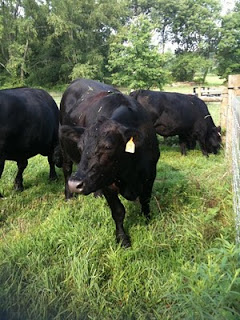Our high school biology classes taught us about the four parts of the cow's stomach. How the cow and other herbivores ate their food, took it to part one & two of their stomach to digest, regurgitated it to chew the cud a bit longer then sent it to part three & four of the stomach. Rumination is an adaption by which herbivores can spend as little time as possible feeding (when they are most vulnerable to predation) and then later digest their food in safer surroundings.
Cows are biologically programmed to digest grasses in such a manner. Corn is not a grass, and therefore bypasses the rumination process. Corn fed cattle grow faster and less naturally than grass fed. A typical corn fed calf is ready for market several months earlier than a grass fed calf. With such efficiency, why does Our Daily Green encourage grass fed meat? Beef from corn fed cattle is about 4 times higher in fat as well as contains virtually no Omega*3. Grass fed beef contains no unnatural growth hormones and additionally is generally slaughtered one animal at a time. (If you've ever wondered about the high number of eColi or mad cow disease outbreaks, they are the result of hundreds, even thousands of animals being factory processed in a single batch. if one cow is sick, the entire lot of meat *especially ground meat* becomes contaminated).
 Last week, I had the pleasure of touring a local farm that sells only grass fed meat to their customers. Walnut Hill Farm in Western Pennsylvania operates a small farm (100 acres or so) that adheres to the principals of slow food. We arrived to see owner Mike Kovach putting his fresh chickens on a spit for a family party later that evening. His gracious wife, Karen, joined us on a tour as they showed us what they are doing with their slice of land. We met their team of ducks, tribe of goats, brood of chickens, and gang of turkeys.
Last week, I had the pleasure of touring a local farm that sells only grass fed meat to their customers. Walnut Hill Farm in Western Pennsylvania operates a small farm (100 acres or so) that adheres to the principals of slow food. We arrived to see owner Mike Kovach putting his fresh chickens on a spit for a family party later that evening. His gracious wife, Karen, joined us on a tour as they showed us what they are doing with their slice of land. We met their team of ducks, tribe of goats, brood of chickens, and gang of turkeys.
They explained their methods for grass feeding and moving their animals around to different pastures. Our family met their beautiful herd of black Angus cattle, with the shiniest coats I've ever seen. It tugged a heartstring, as my grandfather raised black Angus. When Mike used the same cattle call as my grandfather, I traveled back 30 years.
When we left Walnut Hills, it was with complimentary ground beef and a dozen eggs to try. I'm happy to report that it was truly delicious and I cannot wait for my side of beef to arrive. As a side note, free range eggs contain on average 6 times the Vitamin D that caged eggs contain. Chickens raised outdoors in the sunshine transfer the Vitamin D to their eggs.
When we left Walnut Hills, it was with complimentary ground beef and a dozen eggs to try. I'm happy to report that it was truly delicious and I cannot wait for my side of beef to arrive. As a side note, free range eggs contain on average 6 times the Vitamin D that caged eggs contain. Chickens raised outdoors in the sunshine transfer the Vitamin D to their eggs.
If you're interested in finding a small farmer who raised their animals naturally, Local Harvest has an excellent search tool for local farmer's markets, CSAs, co-ops or farms.
additional reading:
From Jo Robinson, Why Grass fed is Best
2 comments :
Thanks so much for the lovely article about our farm! We had at least as much fun showing you around, and we're real glad you enjoyed the samples! Look forward to seeing you guys again real soon!
What a great post Kim!! You do have a way with words.
I am going to head over to facebook later to check them out. Thanks!!!
Post a Comment